Affiliate disclosure: This post may contain affiliate links. Please see our Privacy Policy.
Elderberry wine is a delicious way to use elderberries, and it preserves them for year-round enjoyment at the same time.
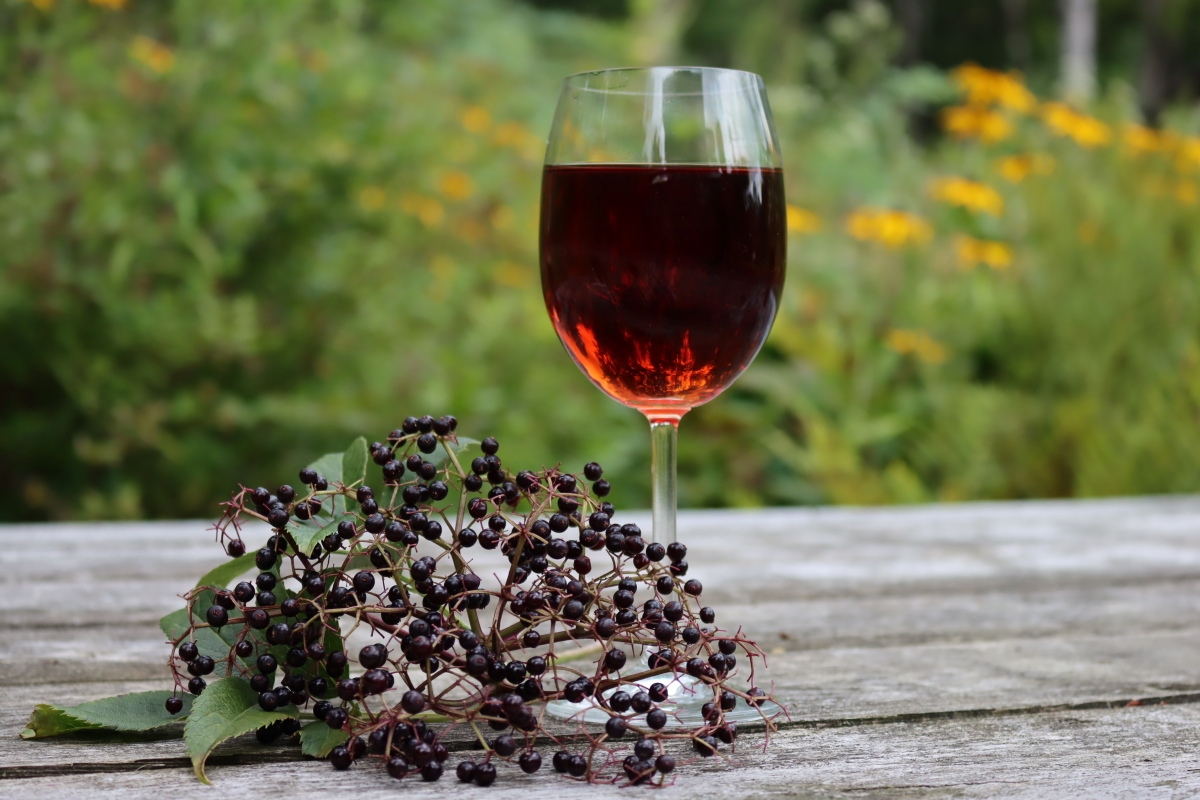
Table of Contents
- Elderberry Wine vs. Elderberry Mead
- Ingredients for Elderberry Wine
- Elderberries (Fresh or Dried)
- Sugar (or Honey)
- Wine Yeast
- Yeast Nutrient (or Raisins)
- Acid Blend (or Lemon Juice)
- Pectic Enzyme
- Tannin
- Equipment for Elderberry Wine
- How to Make Elderberry Wine
- Elderberry Recipes
- Elderberry Wine (& Mead) Recipe
- Winemaking Recipes
- Mead Recipes
Elderberries are one of our favorite crops to grow, and every year we harvest buckets full of their dark, richly flavored fruits. Their flavor is already rich, like a fine red wine and it only makes sense to put them into a bottle.
We made some of our first bottles of elderberry wine back in 2008, and that year we made elderberry mead as well. We had around 26 bottles of the finished brew (from 3 gallons of each elderberry wine and elderberry mead), and we’ve been slowly working through that vintage ever since.
A new batch goes into the carboys each year, but they’re smaller, each about a gallon (roughly 4 bottles). That allows us to compare the wine to the original batch, and it gets better every year.
Elderberry wine and elderberry mead both age exceptionally well, so don’t be afraid to make a big batch (if you have the space to store it). We’re now down to our last few bottles from the original 26, and though it’s had a good run for just shy of 15 years, I wish I’d made more.
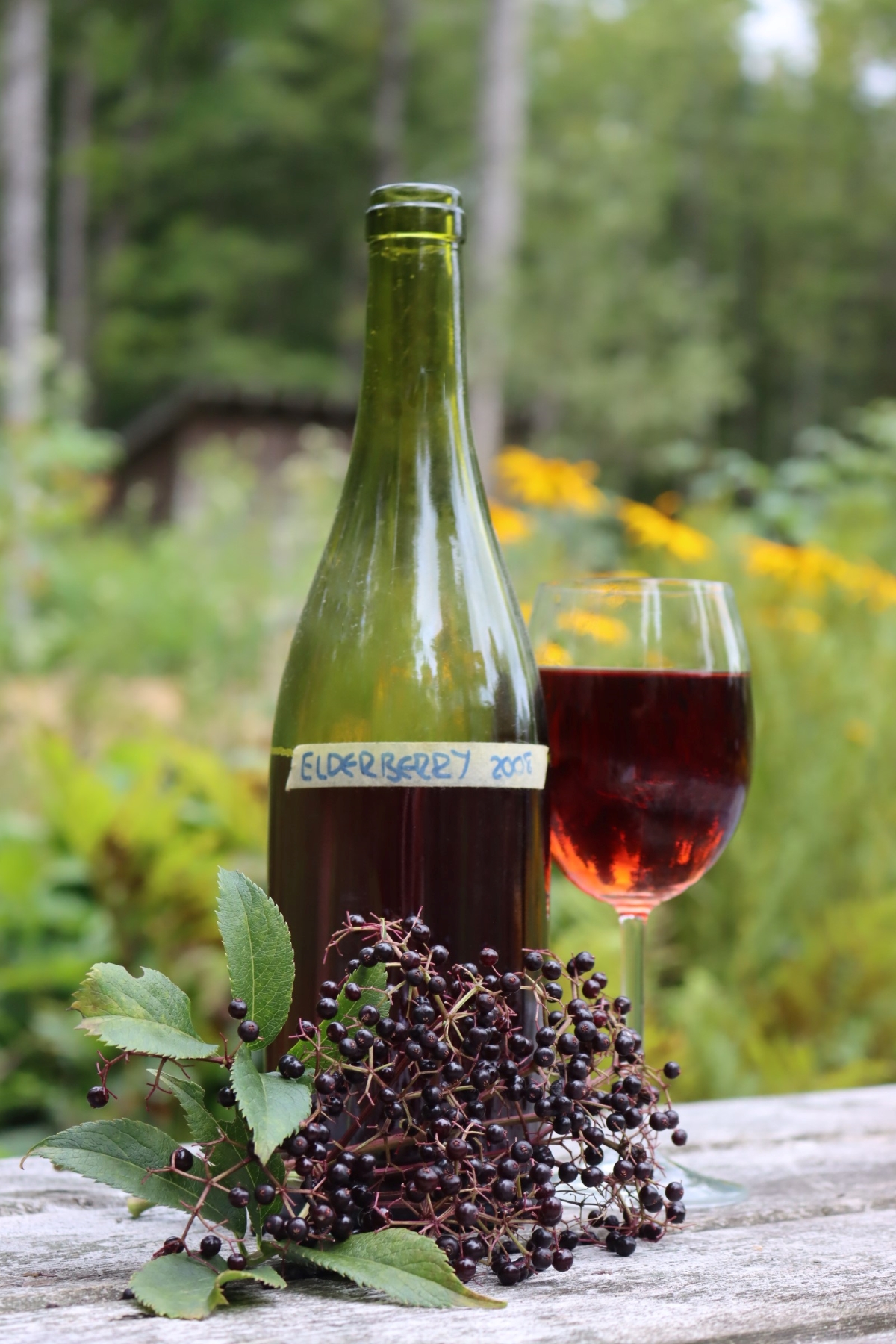
Elderberry Wine vs. Elderberry Mead
The main difference between elderberry wine and elderberry mead is the choice of sweetener. Unlike grapes, elderberries don’t have enough natural sugar to make a shelf-stable wine.
The yeast would quickly eat all their available sugar, leaving something very dry and not very alcoholic.
For wine, you add sugar and that feeds the yeast and allows for a bit of residual sweetness in the finished wine. With mead, the sweetener is honey, which not only adds flavor, it also changes the character of the beverage.
Honey wines have an incredible body and a much better mouthfeel than straight sugar-based country wines. They ferment slower since honey is harder for the yeast to digest. That means a lot of the volatile flavor compounds, both in the elderberries and in the honey, are preserved.
The downside is honey costs a lot more than sugar, around 5 times as much per pound. The longer fermentation time also means you’ll be waiting longer before you can drink the finished beverage.
Personally, I prefer mead because I think wine often comes out a bit too light in body and doesn’t stand up quite as well to the rich flavor of elderberries. A full-bodied honey mead tends to balance the deep red wine notes in elderberries.
I’m already working with elderberries which are medicinal berries, I might as well go all in and use honey (even though it’s a bit more expensive).
Nonetheless, even if I prefer mead, they’re both truly exceptional, and I’ll give you instructions for making both elderberry wine and mead at home.
Ingredients for Elderberry Wine
While it may be possible to make grape wine with just sweet, vine-ripened wine grapes, other types of fruit wines require a few more ingredients to get the job done.
Grapes are sweeter than other fruits, and they’re the only ones with enough natural sugars to ferment completely without becoming unpalatably dry. They also have natural tannins to improve body and mouthfeel in the finished wine, and enough acidity to create a hospitable environment for successful fermentation.
Elderberries, on the other hand, have plenty of flavor and natural antioxidants, but they lack all the other essential characteristics that are required for good homemade wine.
No worries, it’s easy enough to resolve, and the process is no different than making any other country fruit wine. You’ll need the following:
Elderberries (Fresh or Dried)
The fruits can be either fresh or dried, and in both ways the results are spectacular.
If using fresh fruit, they’ll be juiced to extract their flavor. Fresh elderberries are hard to come by since they spoil fast, so you’ll likely only have access to these if you’re growing elderberries.
In the case of dried elderberries, you’ll simmer them in water to make an elderberry extract for this recipe. When dried they lose about half their volume, so you’ll only need about half as much dried elderberry for the same flavor.
This recipe uses 5 pounds fresh elderberries, which works out to about 10 cups of stemmed fruit. If you’re using dried, you’ll want about 5 cups of dried elderberries.
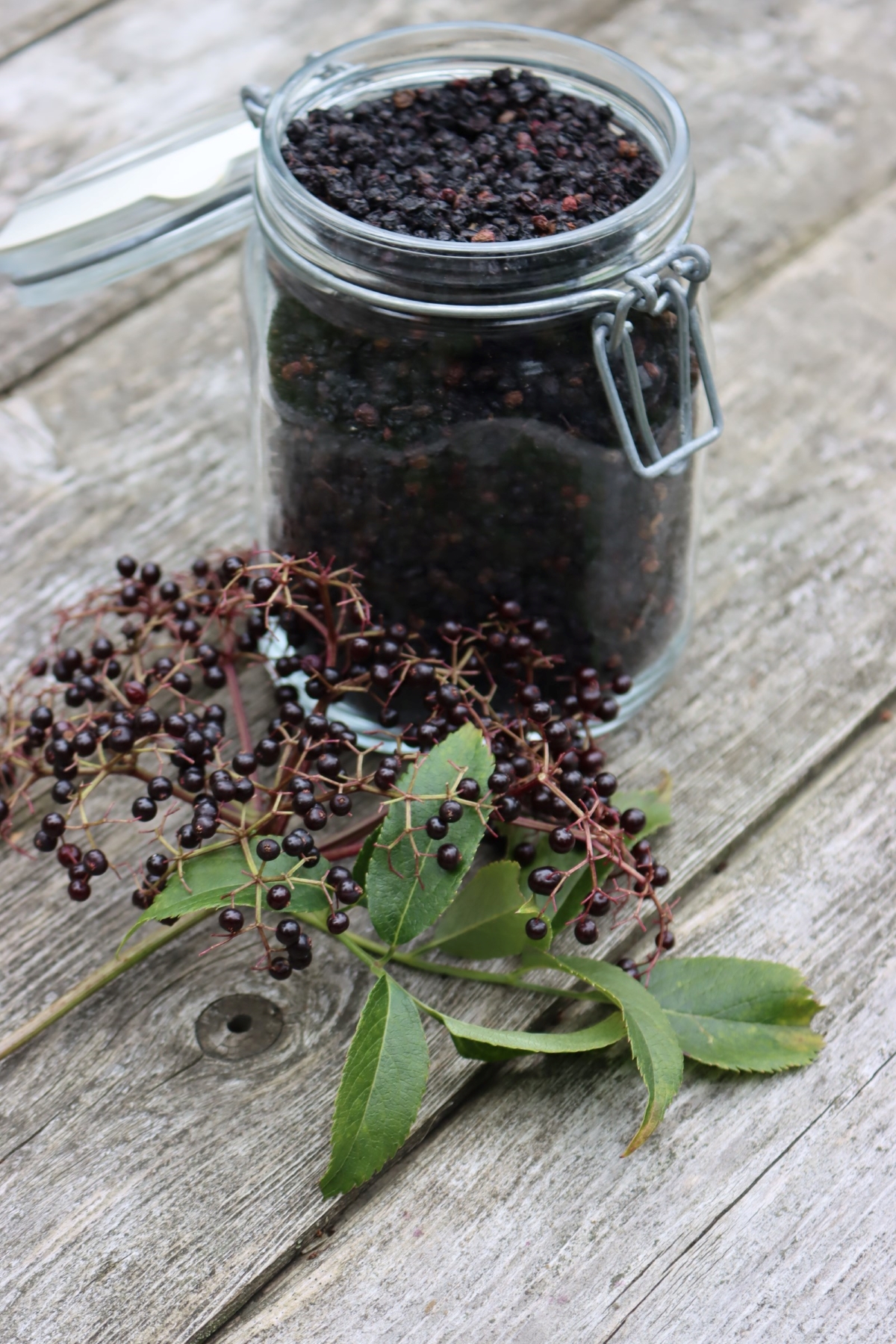
Sugar (or Honey)
Wines need a certain minimum amount of sugar to feed the yeast, and if there’s not enough the yeast will quickly consume it all and stall out. The result is a very dry wine that’s not alcoholic enough to prevent spoilage.
By adding sugar, or honey, you’re giving the yeast enough fuel to make enough alcohol to stabilize the wine, plus a bit extra so that the wine is balanced (not too dry). This is not optional.
For a gallon, you’ll need roughly 2 1/2 pounds of sugar, or about 3 pounds of honey.
Wine Yeast
The actually finished alcohol level is determined by your choice of yeast (not how much sugar you add). Different strains of yeast have different alcohol tolerances, which means they die out when the ABV reaches a certain percentage.
Beyond producing alcohol, wine yeast actually contribute a lot of flavor to the finished wine. They can metabolize acids into different compounds, and produce volatile esters that can give floral, fruity, or other flavors to the wine.
Do not use bread yeast…that warm yeasty scent of rising bread doesn’t come from the flour, it comes from the yeast. Your finished wine will taste like bread.
Good choices for elderberry wine include:
- Lavin D47 ~ Adds strong floral and fruity characteristics to wines, and would complement the complexity of elderberry wine nicely. Only a moderately vigorous fermenter, so it may start slowly. Alcohol tolerance to 15%, ideal temperature range 59 to 86 F.
- Montrachet or Premier Classique ~ A strong fermenter known for producing full-bodied red wines. It preserves the natural tannin content of the fruit and leaves the wine with intense color. Alcohol tolerance is relatively low (only 13%), so a good choice if you’d like more residual sweetness. Ideal fermentation temperatures 59 to 86 F.
- Cote des Blancs (Geisenheim Epernay) ~ This yeast enhances the fruity notes and natural sweetness in both red and white wines. Known for its slow fermentation and minimal foaming, it may take a bit longer to complete, but it helps preserve delicate flavors and aromatic esters. It has a lower alcohol tolerance, especially when fermented at cooler temperatures, which results in higher residual sugars. It can tolerate alcohol levels up to 12-14%, with an optimal fermentation temperature range of 64 to 86°F.
- Red Star Premier Cuvee or Lavin EC-1118 ~ Generally known as champagne yeasts, these are strong fermenters with a neutral taste. They’ll get the job done efficiently, but without adding much flavor (good or bad). If you choose this yeast, I’d suggest adding an extra 1/4 pound of sugar to the batch so it doesn’t come out too dry. It has a high alcohol tolerance, usually around 15% but up to 18% in ideal conditions, so without extra sugar you’ll have a very dry wine. Ideal temperature range 59 to 86 F.
Yeast Nutrient (or Raisins)
While grapes have all the nutrients that wine yeast needs to survive, other fruits are often deficient. Adding powdered yeast nutrient is a simple way to ensure the yeasts have everything they need to thrive (since they can’t live on just sugar alone).
You can also add in a handful of raisins which will give them trace nutrients, but it’s less dependable, and the raisins tend to add flavor to the finished wine. (Not Optional)
Acid Blend (or Lemon Juice)
Though elderberries are fruits, they’re not very acidic. Most other fruits have more acidity, and in fact, they’re not even acidic enough for canning when you make homemade elderberry jelly (unless you add lemon juice).
Wines need a certain amount of acidity to create a hospitable environment for the yeast, bring out the flavor of the fruit and balance the residual sweetness. You can use a powdered acid blend that is formulated for winemaking and yields consistent results, or you can use lemon juice.
(You’ll need 1 TABLEspoon of lemon juice for every teaspoon of acid blend in a recipe.)
Most fruit wine recipes use around 1 tsp per gallon, but elderberry are especially alkaline so I’d suggest going with 1 1/2 tsp per gallon. If you’re setup to test for pH, you’re looking for a ph between 3.4 and 3.6 to start, or if not, you can just go with the generic recommendation of 1 1/2 tsp per gallon.
Pectic Enzyme
This is a natural enzyme that breaks down pectin in fruits, which helps clarify the wine. It’s mostly necessary for high pectin fruits like apples when you’re making apple wine, but it’s helpful even for low pectin fruits like elderberries.
Adding pectic enzyme powder optional, but using it will clarify the wine and give you a better-finished look in the glass. It’s completely optional.
(Freezing the fruit also breaks down pectins, so that’s another alternative.)
Tannin
The natural tannin in grapes, especially grape skins, balances out the natural sweetness of wine. More importantly, it also contributes to mouthfeel and can give wine what’s known as “body.” Without a bit of tannin, wine tastes thin and watery, even if it otherwise has plenty of flavor.
While most fruits lack natural tannins, elderberries actually contain tannins just like grapes. You can add winemaking tannin if you like, which will give a bit more bite to the wine, but it’s not necessary in this case.
We use tannin powder in almost all our home winemaking recipes, but it’s optional in elderberry wine. If you do add it, go with just a tiny pinch.
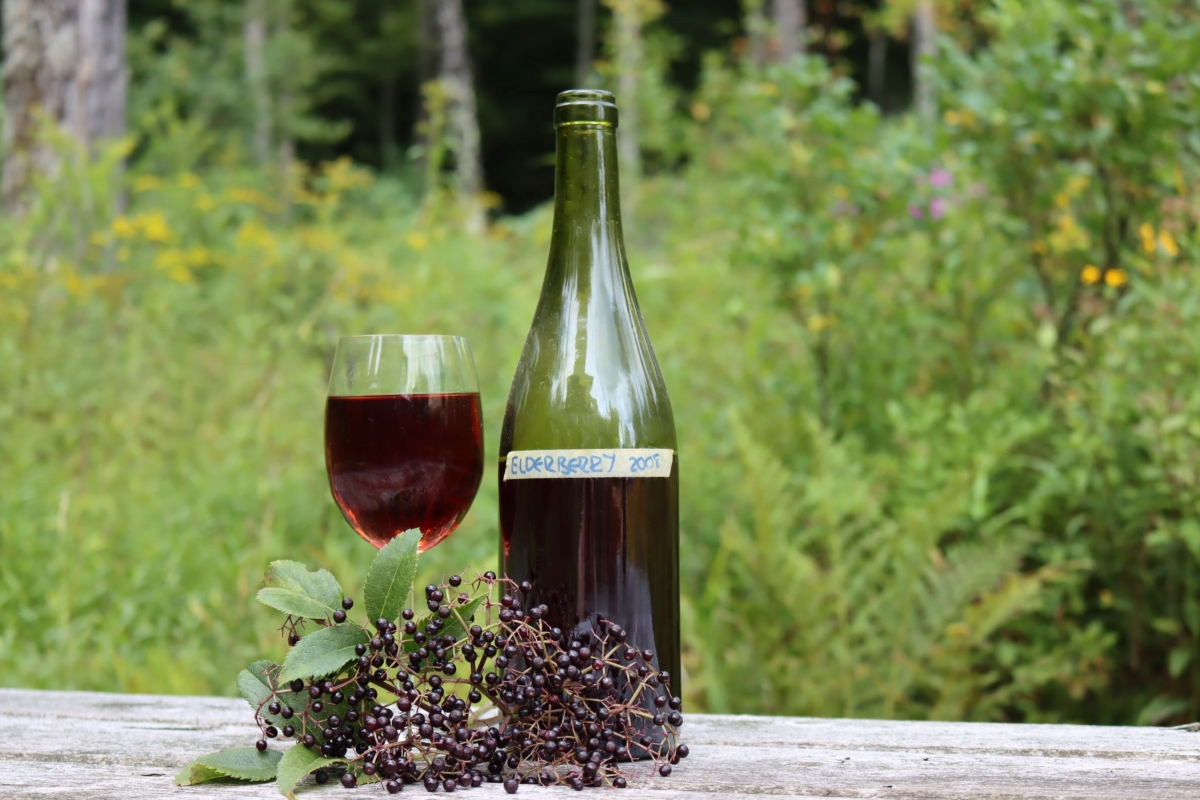
Equipment for Elderberry Wine
The equipment you need to make elderberry wine is pretty basic, and it’s the same stuff you’d need to make homemade beer, hard cider, or really any fermented beverage.
A small upfront investment will keep your bottles full for a lifetime.
One Gallon Glass Carboy (x2) ~ A narrow neck fermentation vessel, also called a carboy, contains the elderberry wine during fermentation (primary and secondary). The narrow neck minimizes air exposure, keeping it from turning to fruit vinegar. You’ll need two (one-gallon each).
Rubber Stopper and Water Lock ~ Basically a one-way valve that allows CO2 to escape, but prevents contaminants from entering the fermentation vessel. Basically, it limits oxygen exposure to prevent the wine from turning to vinegar (especially during secondary fermentation).
Both the fermenter, water lock, and rubber stopper often come in a kit that includes all three.
Brewing Siphon ~ Used to move the elderberry wine from one container to another and allows you to neatly leave the sediment behind. If you just pour the mixture, you’ll get sediment into the mix, and you’ll add oxygen which helps promote vinegar (rather than alcohol). A siphon is also the best way to bottle the wine.
Wine bottles ~ The best option for bottling, and really the only thing I recommend for elderberry wine since it’s best after bottle aging. You can also use flip top Grolsch bottles, but that’s only good for short-term storage. You’ll also need a Bottle Corker as well as clean, new corks for bottling.
Lastly, Brewing Sanitizer is a one-step no-rinse sanitizer that cleans everything and helps to prevent contamination. It’ll make the winemaking process more predictable, and it’s always good to keep your equipment clean.
How to Make Elderberry Wine
The process for making elderberry wine is the same as making any other type of fruit wine. The basic steps are as follows:
- Juice the Elderberries (or make an extract from dried elderberries)
- Dissolve sugar or honey in the juice, along with the other additives
- Add water to fill the fermentation vessel
- Dissolve yeast in a bit of water to re-hydrate, and then add it to the mix
- Seal with a water lock and ferment for 10 to 14 days (Primary Fermentation)
- Use a siphon to transfer the mix to a different container, leaving the sediment behind
- Re-attach the water lock and ferment for another 4 weeks to 6 months.
- Bottle the wine
- Bottle age at least 2 weeks, preferably 2 to 12 months, before drinking
The whole process starts by first stemming and then juicing the elderberries. The stems where the elderberries are attached to the bunch can give a bitter flavor to elderberry wine, and it’s best to remove them before getting started.
I know, it’s a pain to stem elderberries…but it’s worth it. Freezing the clusters can make it easier to stem them, as they pop right off when frozen with just a gentle combing of your fingers.
(Freezing also denatures some of the pectin in fruits, which can make wine cloudy. Elderberries are already low pectin, but freezing them will still help clarify the wine in the end, so it’s helpful beyond just de-stemming.)
Once they’re stemmed, they can be juiced by placing them in a pot with enough water to just cover. Bring it to a gentle simmer, masing with a potato masher to help the fruit fall apart.
Strain through a double layer of cheesecloth or a jelly bag. Discard the solids.
(Alternately, you can place the elderberries in a brew bag and place it into your fermentation bucket for primary. I think it’s cleaner to just juice them and discard the solids, and the flavor is about the same either way.)
Next, dissolve the sugar (or honey) in the extracted juice, adding enough water to bring the total volume up to a bit short of a gallon. (You’ll need a bit of extra space for the yeast and other ingredients.)
Gently warming the mixture on the stove can help the sugar or honey dissolve. Once dissolved, cool completely, and add the remaining ingredients (except yeast). Stir to incorporate.
Pour the mixture into a fermentation vessel, usually a narrow neck demijohn (aka. 1-gallon carboy). Dissolve the yeast in a bit of water and allow it to re-hydrate for about 10 minutes. Next, pour it into the fermentation vessel.
Cap the fermentation vessel with a water lock and allow the mixture to ferment for 7 to 10 days. This is known as primary fermentation and it’s when the bulk of the sugar will turn into alcohol. It should be vigorous, with a lot of bubbling.
When things calm down and it’s only bubbling once every few minutes, usually at around 7 to 10 days, it’s time to use a sciphon to move the mixture to a clean fermentation vessel. The “lees” of sediment on the bottom of the container can contribute off-flavors to a batch, so you need to get the elderberry wine off of them for secondary fermentation.
In secondary fermentation, things are going to go a lot slower, but this is where most of the complex flavors develop. You shouldn’t see a lot of bubbling, but the yeast are still working, albeit slowly. The flavors in the wine will mellow, and a lot of the character is developed in this stage.
Leave the wine to ferment in secondary for at least 3 to 4 weeks (with a sugar wine) or at least 2 months for a mead. If you have the patience, waiting about 6 months to bottle will usually improve the finished quality dramatically. (After 6 months, additional time doesn’t really improve the wine that much, as most of the gains happen in that initial 6 months of secondary).
Anywhere in between also works, it really comes down to your patience.
Once you’re ready to end secondary fermentation, bottle the wine (or mead) in wine bottles with corks.
If you’re not planning on aging the wine, you can get away with flip-top Grolsch bottles if you’re only storing the wine for 1-2 months. Anything longer than that and you’ll really want wine bottles, which I recommend for quality in any case.
Elderberry wine is drinkable after a few weeks in the bottle, but it won’t be at its prime. I’d suggest waiting at least 6 months to allow the wine to bottle condition.
It’ll only get better with age after that.
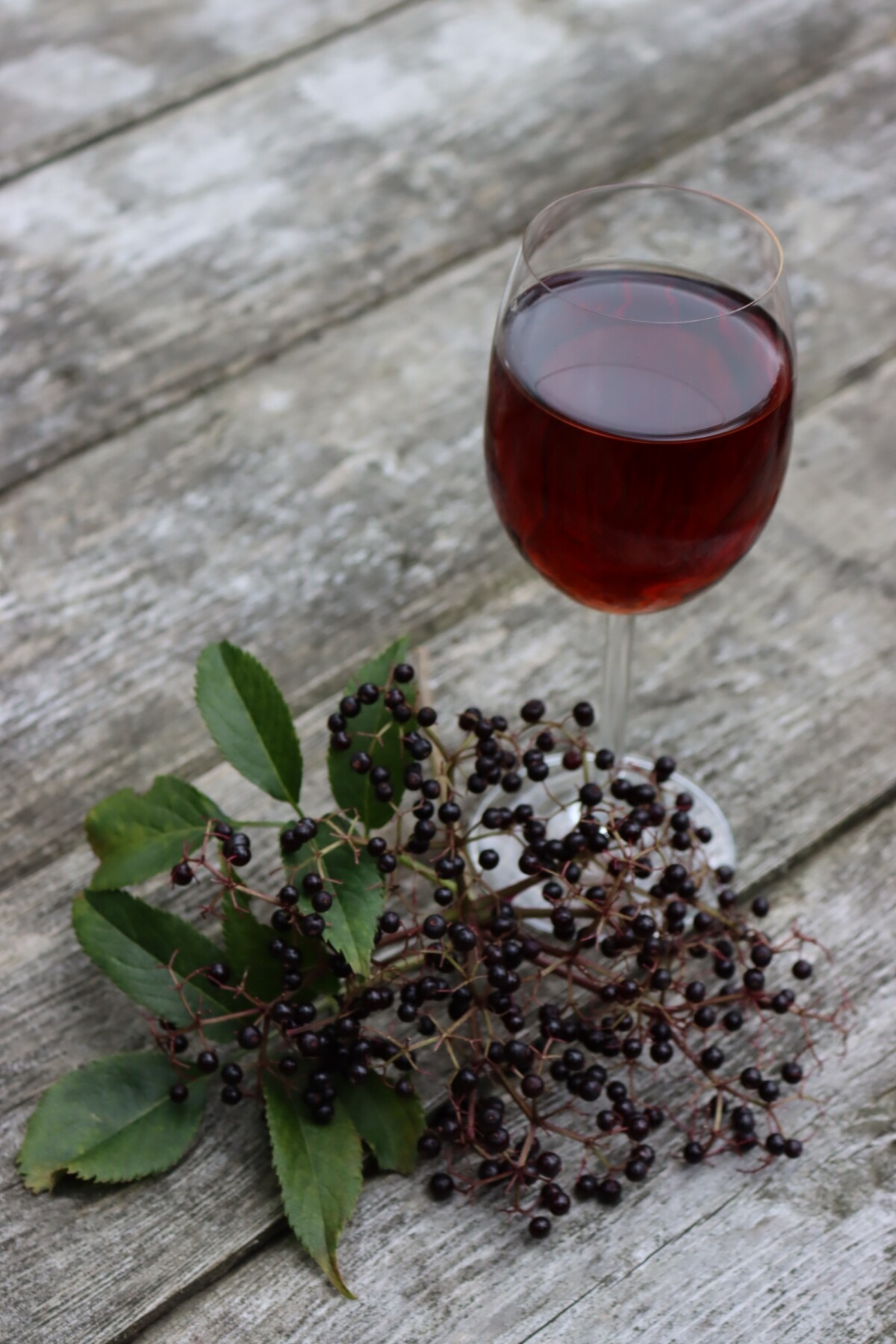
Elderberry Recipes
Looking for more ways to use elderberries?
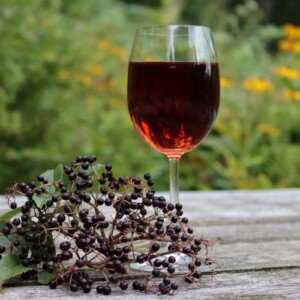
Elderberry Wine (& Mead)
Equipment
Ingredients
- 5 lbs fresh elderberries, about 10 cups fresh stemmed fruit (or 5 cups dried fruit)
- 2 1/2 pounds sugar, or 3 lbs honey
- 1 1/2 tsp acid blend
- 1 tsp yeast nutrient
- 1/2 tsp Pectic Enzyme
- 1 wine yeast, see notes
- Water to fill
Instructions
- Sanitize all equipment before beginning.
- Stem the elderberries (if fresh) and juice them by placing them in a stockpot. Add water to just barely cover and simmer for a few minutes, mashing with a potato masher to help them release their juices. (If using dried elderberries, simmer 5 cups dried elderberries in about 10 to 12 cups water for about 15 minutes.)
- Strain through a jelly bag or double layer of cheesecloth. Discard solids and retain juice.
- Pour the juice back into a clean pot and add sugar (for wine) or honey (for mead). Slowly warm while stirring to encourage the sugar to dissolve. When fully dissolved, remove from heat and cool completely.
- Add remaining ingredients (except yeast) and stir to incorporate. Pour cooled mixture into a fermentation vessel and add water until nearly full, leaving space to the yeast.
- Dissolve the yeast in a small amount of water (1/4 to 1/2 cup) and allow it to rehydrate for 10 minutes. When rehydrated, add it to the fermentation vessel with the rest of the ingredients.
- Seal the fermentation vessel with a water lock and allow the mixture to ferment in primary for 7 to 10 days, until fermentation slows.
- When fermentation slows, use a siphon to rack the mixture into a clean fermentation vessel, leaving the sediment behind. Add clean, chlorine-free water to fill.
- Re-seal the vessel with an airlock and ferment in secondary for at least 4 weeks, preferably much longer and up to 6 months. Honey meads need longer in secondary.
- Bottle the mead in wine bottles with corks, and bottle age for at least a few weeks (preferably several months or years) before drinking.
Notes
- Lavin D47 ~ Adds strong floral and fruity characteristics to wines, and would complement the complexity of elderberry wine nicely. Only a moderately vigorous fermenter, so it may start slowly. Alcohol tolerance to 15%, ideal temperature range 59 to 86 F.
- Montrachet or Premier Classique ~ A strong fermenter known for producing full-bodied red wines. It preserves the natural tannin content of the fruit and leaves the wine with intense color. Alcohol tolerance is relatively low (only 13%), so a good choice if you'd like more residual sweetness. Ideal fermentation temperatures 59 to 86 F.
- Cote des Blancs (Geisenheim Epernay) ~ Brings out the fruit character and sweetness of both red and white wines. A slow fermenter with low foaming, it'll take longer to finish but help to maintain volatile esters and subtle flavors. Low alcohol tolerance, especially when fermented at low temperatures, which means more residual sugars. Alcohol tolerance to 12-14%, ideal temperature range 64 to 86 F.
- Red Star Premier Cuvee or Lavin EC-1118 ~ Generally known as champagne yeasts, these are strong fermenters with a neutral taste. They'll get the job done efficiently, but without adding much flavor (good or bad). If you choose this yeast, I'd suggest adding an extra 1/4 pound of sugar to the batch so it doesn't come out too dry. It has a high alcohol tolerance, usually around 15% but up to 18% in ideal conditions, so without extra sugar you'll have a very dry wine. Ideal temperature range 59 to 86 F.
Nutrition
Nutrition information is automatically calculated, so should only be used as an approximation.
Winemaking Recipes
Keep your carboy bubbling with these home winemaking recipes:
Mead Recipes
Honey wines are my favorite, and there are plenty of mead recipes to choose from…
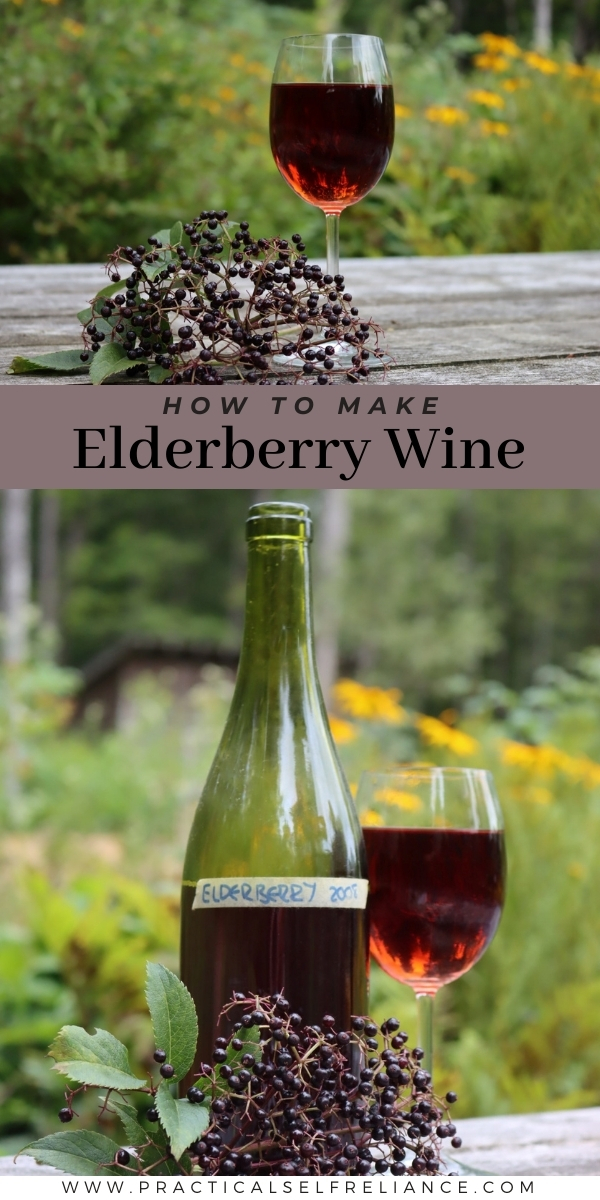


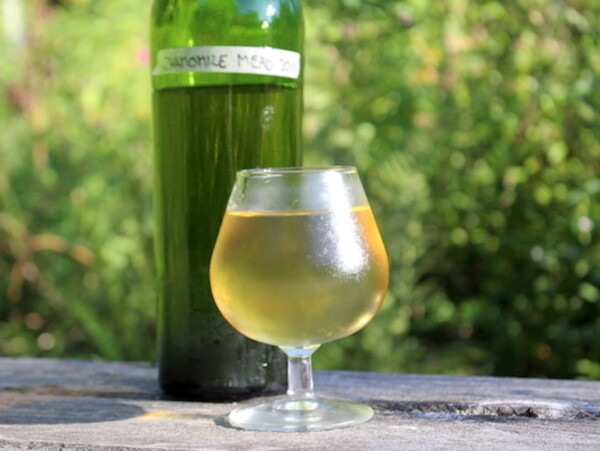
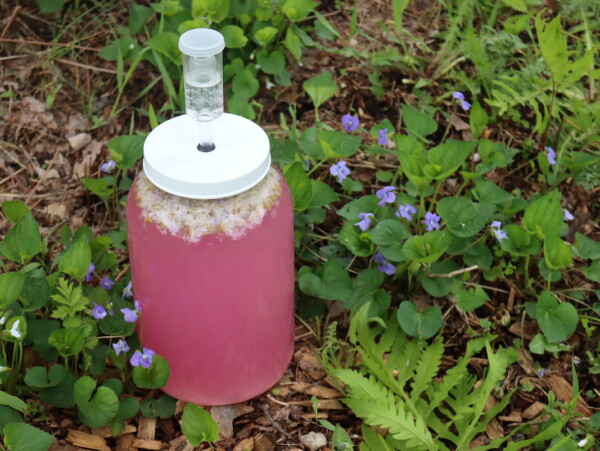










If you were trying to save money is there a way that you could do something like half honey and half sugar?
Sure, you can do half honey and half sugar, that’s perfectly fine. I know, honey is really expensive right now!
Hi! This seems more geared for wine. I’m looking for a solid elderberry mead recipe. Ive used a lot of your recipes before and never steered me wrong but I need some help with this one LOL Can you help me out? I have a 3 gallon carboy and have only ever made dandelion mead. Looking for specific directions (because honey is stupid expensive and I dont want to screw this up!!) Thank you!!!
Hi Jen, Over here, we almost always make meads, because quite frankly, they taste infinitely better than sugar wines. I write my recipes sugar wine focused because for some reason almost everyone is looking for wine recipes rather than mead recipes. Possibly because honey is stupid expensive, but possibly because they just don’t know how darn good mead is. Every picture in that article is mead. Anyhow, elderberry mead is one of our favorites, and it works just fine with either fresh or dried berries. I just read back through that article to be doubly sure, but yes, follow that procedure for elderberry mead. Using 3 lbs of honey per gallon yields a reasonably sweet (but not cloying) mead. Choose a wine yeast that has an alcohol tolerance of 13 to 15%, avoiding champagne yeasts which will be too dry.
The recipe card in this article allows you to choose to scale it up 2x or 3x. All ingredients should be scaled up for your 3 gallon carboy except the yeast. One packet works fine for anywhere between 1 gallon and 5 gallons (they multiply rapidly, so it’s just a starter population anyway).
I hope this helps, please do let me know how it goes for you or if I can answer any other questions.
I was able to harvest 14oz or around 3 cups of fresh elderberries last summer (I froze them) and would like to substitute the rest with dried ones. What ratio would you recommend?
The recipe calls for 10 cups of fresh elderberries. So if you have 3 cups then you need 7 more. The dried will lost about half the volume. Half of 7 is 3.5. So you will use 3 cups of fresh and 3.5 cups of dried.
Is using frozen elderberries a nonstarter?
Are you asking if you can use frozen elderberries for the wine?
Yes! My friend has about 5 lbs of frozen elderberries and I was wondering if I can use them to make elderberry wine.
Of course you can!
Thanks!
So I would be using dried elderberries and I see it says 5 cups but what would that be in lbs? On amazon the bags they sell come in 1 lb so I need to know how many bags to buy. Thanks!
I would plan for about 4 cups per pound of dried elderberries. So if you got two bags, you should have plenty.
I want to make elderberry wine or maybe mead. How many cups of juice do I need? Is there a juice/sugar or honey ratio?
This particular recipe is for a gallon. You will want enough juice to mostly fill the gallon carboy. You can add a little water to fill it but the more water you add, the more diluted the flavor will be. For a gallon you will want about 2 1/2 pounds of sugar or 3 pounds of honey.
Thank you so much for this article. I was gifted an elderberry cutting and now its 7ft tall:) Its going on two years and its now fruiting. I can’t wait to make the elderberry wine. My question is how long do you cook the berries for? I was told that they should be cooked for at least 45 minutes to remove the toxin. Can you please advise? Thanks.
Cooking for 45 minutes to remove the toxin is definitely overkill, they just need to be brought to a boil for about 5 minutes. Alternately, fermentation is supposed to remove the toxin as well, so in theory they could be used raw in this recipe.
Does making the berries into wine diminish the immune support qualities of the elderberries?
It shouldn’t. The berries actually need to be cooked or fermented to be consumed, according to most sources and shouldn’t be eaten raw/un-fermented. This is one way to consume them without cooking them, which in theory should maintain more of their antioxidant properties…but there’s not actually studies on this subject in particular (that I now of).
Thank you for the information on how to make elderberry wine. My grandfather made excellent elderberry wine but I never learned how he made it. I’ll have to try in the future. Unfortunately, he were able to pick the berries along railroad tracks which have now been sprayed by both the farmers and railroad and there are few bushes left.
You’re welcome. It’s so hard to find good foraging spots that haven’t been sprayed. I planted my own elderberry bushes right by the house. That way I know they aren’t sprayed and I can get to them before the birds.
Not that I needed any more reason to try this recipe out, but I’m glad to know that elderberry is great for the immune system, which is quite important nowadays.
Yes it is and elderberries are definitely great for the immune system.